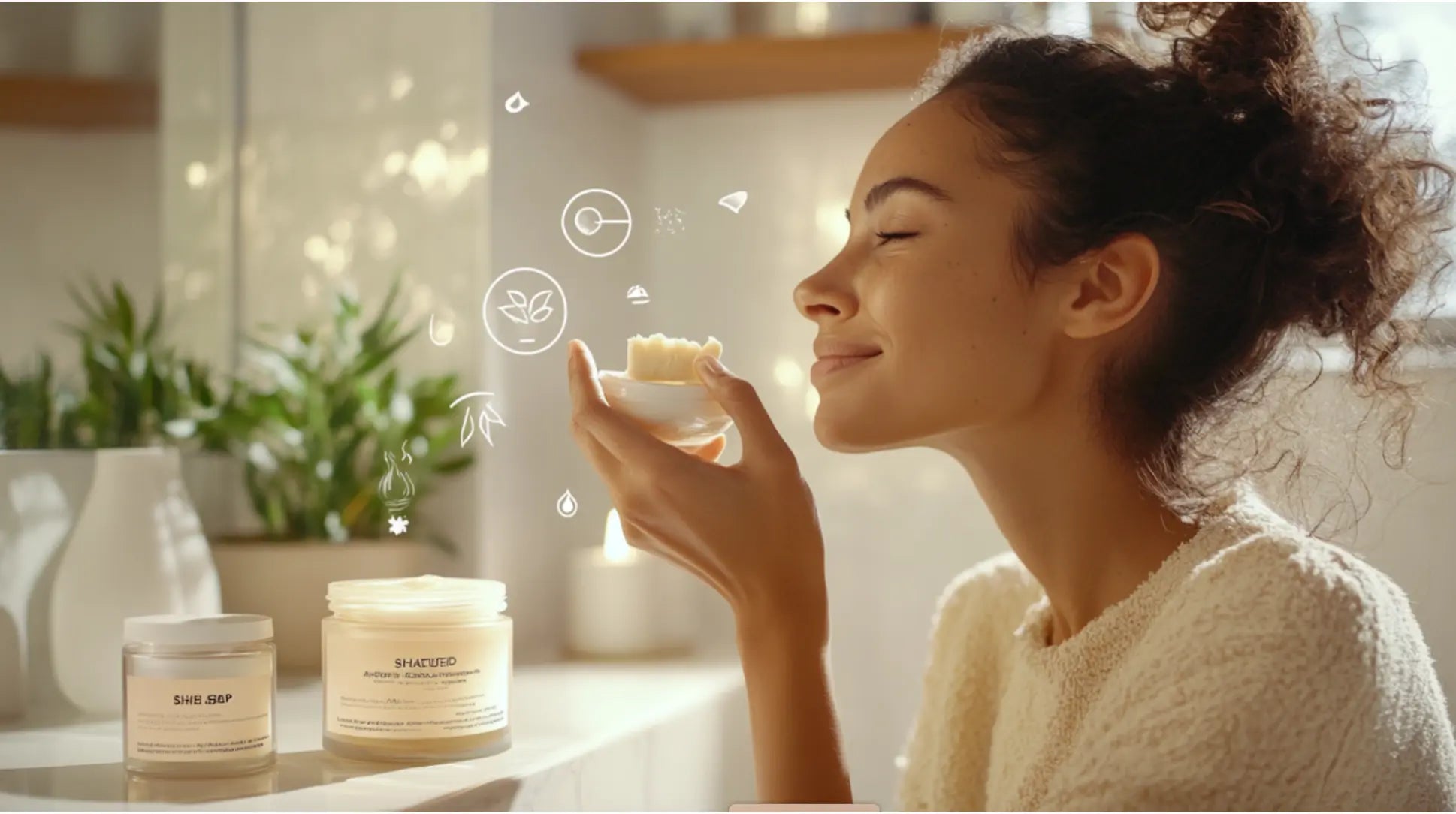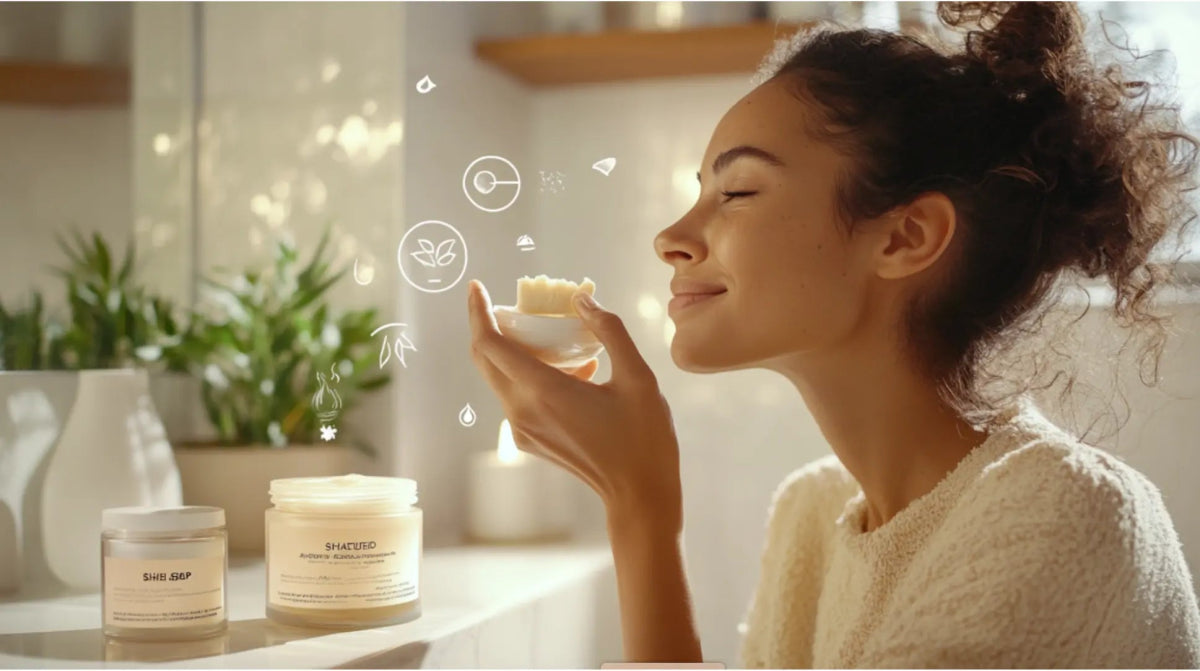
Dealing with acne can be a delicate balance, especially when it comes to choosing moisturizers.
You're constantly wondering if a rich ingredient will soothe your skin or, frustratingly, make breakouts worse. Among the many natural options, shea butter is a popular favorite, known for its incredible moisturizing power.
But for those of us battling acne, a big question looms: Can this beloved natural butter actually help calm and clear acne-prone skin? Or will it just clog pores and lead to more frustration?
It’s a common dilemma, and we're here to clear up the confusion. This article will dive deep into shea butter's properties, exploring its potential benefits and risks for blemish-prone skin. Let's find out if shea butter can be a friend on your journey to clearer skin.
What is Shea Butter? A Quick Look at This Natural Powerhouse
Before we explore how shea butter might affect acne-prone skin, let's quickly understand what this natural wonder actually is. It's much more than just a simple moisturizer; it's a gift from nature.
Origins and Types: Unrefined vs. Refined
Shea butter is a rich fat extracted from the nuts of the magnificent African shea tree. For centuries, it's been a vital staple in African communities for both culinary and medicinal purposes, including skincare. When you're looking for shea butter, you'll mainly encounter two types: unrefined and refined.
Unrefined (or raw) shea butter is minimally processed, retaining most of its natural vitamins, nutrients, and characteristic nutty, earthy scent.
It often has a yellowish or ivory color. Refined shea butter, on the other hand, undergoes more processing, which can strip away some of its beneficial compounds, color, and scent, resulting in a whiter, odorless product.
Key Components for Skin Health
Shea butter's nourishing power comes from its impressive composition. It's packed with a balanced blend of fatty acids, notably oleic and stearic acids, which are fantastic for moisturizing your skin. But its magic doesn't stop there!
It also boasts healthy doses of Vitamins A and E, known for their antioxidant properties. Most crucially for skin health, it's rich in Vitamin F (linoleic acid), which is vital for maintaining a strong skin barrier.
Plus, it contains unique unsaponifiable matter—compounds that contribute to its renowned healing and anti-inflammatory properties, making it truly special for your skin.
The Comedogenic Question: Will Shea Butter Clog Pores?
When you have acne-prone skin, the first question that pops into your head about any new moisturizer is, "Will this clog my pores?" It’s a completely valid concern, and with richer ingredients like shea butter, it's essential to understand its comedogenic potential.
Read More: Shea Butter for Oily Skin? Benefits & How to Use
Understanding Comedogenic Ratings: A Quick Guide
You've probably seen "non-comedogenic" labels on products, but what does it really mean? Ingredients are often given a comedogenic rating on a scale from 0 to 5.
A 0 means it’s highly unlikely to clog pores, while a 5 means it’s very likely. These ratings are typically based on animal or lab tests, aiming to guide consumers toward safer choices.
Shea Butter's Rating: Generally Low
Here’s the good news: unrefined shea butter generally boasts a low comedogenic rating, often falling between 0 and 2. This means it's considered unlikely to clog pores for most individuals. Its specific fatty acid composition is well-tolerated by the skin, allowing it to provide rich moisture without creating blockages.
Individual Skin Sensitivity: The Ultimate Test
While ratings are helpful guides, your skin is unique! No rating is absolute. Even if an ingredient is rated low, individual skin chemistry can react differently. That's why the real test always comes down to your skin.
For acne-prone individuals, a patch test is non-negotiable before applying shea butter all over your face. Apply a tiny amount to a small area for a few days to check for any adverse reactions.
How Shea Butter Might Help Acne-Prone Skin
Even with the concern about clogged pores, shea butter brings a powerful set of benefits that could actually be a friend to acne-prone skin. It’s not just about moisturizing; it's about soothing and strengthening.
Anti-Inflammatory Action: Soothing Redness and Irritation
Inflammation is a major player in acne, causing that tell-tale redness and swelling. Shea butter is renowned for its natural anti-inflammatory compounds, particularly its unique unsaponifiable fraction.
These components can help calm angry breakouts and reduce the overall irritation, contributing to a more even-toned and comfortable complexion.
Barrier Repair and Strengthening: A Protective Shield
A healthy skin barrier is your first defense, especially when dealing with acne. Many acne treatments can compromise this barrier, leading to dryness and increased sensitivity.
Shea butter, rich in linoleic acid (Vitamin F), helps to repair and strengthen your skin's natural protective layer. This prevents moisture loss and acts as a shield against external irritants that can worsen acne.
Read More: How Shea Butter Helps Soothe Sensitive Skin
Non-Drying Moisture: Crucial for Acne Routines
Paradoxically, overly dry skin can sometimes trigger more breakouts as your skin tries to overcompensate with oil production.
Shea butter provides rich, non-stripping hydration. It delivers deep moisture without feeling greasy, helping to keep your skin balanced and supple. This can prevent the dryness and irritation often associated with active acne treatments.
Antioxidant Protection: Fighting Damage
Our skin is constantly exposed to environmental stressors that generate free radicals, which can contribute to inflammation and cellular damage. Shea butter contains natural antioxidants like Vitamins A and E.
These powerful defenders help neutralize free radicals, protecting your skin cells and supporting overall skin health, which can indirectly aid in managing acne.
Read More: Antioxidants in Natural Sunscreens: Benefits & Role
When Shea Butter Might Not Be Best for Your Breakouts
While shea butter offers promising benefits for acne-prone skin, it's crucial to acknowledge that it's not a universal solution. For some individuals, or under certain conditions, it might not be the best choice for managing breakouts.
Over-Application & Heavy Feel
Shea butter is incredibly rich. If you apply too much, or if your skin is naturally very oily, it can feel quite occlusive or heavy on your complexion.
This sensation, while not necessarily pore-clogging for everyone, might feel uncomfortable or could potentially create an environment that exacerbates breakouts for some very oily skin types.
Read More: How Shea Butter Can Help with Stretch Marks & Scars
Read More: Shea Butter Cream Recipe - DIY Natural Skincare
Impure or Refined Varieties
The type of shea butter matters immensely. Refined shea butter often loses some of its beneficial compounds during processing and might contain added ingredients that could be pore-clogging or irritating.
Even impure unrefined shea butter that isn't ethically sourced or properly stored could pose a risk. Sticking to high-quality, pure versions is key to minimizing potential issues.
Not a Standalone Acne Treatment
It's important to set realistic expectations. While shea butter can offer supportive benefits like reducing inflammation and strengthening the skin barrier, it is not a primary acne treatment.
It won't actively kill acne-causing bacteria, exfoliate pores, or regulate oil production in the same way ingredients like salicylic acid or retinoids do. Relying solely on shea butter for moderate to severe acne may lead to continued breakouts.
Individual Sensitivities or Allergies (Rare)
Though rare, it's possible for individuals to experience an allergic reaction to shea butter. Even natural ingredients can trigger sensitivities in some people. If you notice any unusual redness, itching, or irritation after a patch test, it's a sign that shea butter might not be compatible with your skin.
Tips for Using Shea Butter on Acne-Prone Skin
If you've decided to give shea butter a try for your acne-prone skin, smart application and product selection are key. A little know-how can help you maximize its benefits and minimize any potential risks.
Choosing the Right Type: Go Unrefined!
This is crucial. Always reach for unrefined, pure, organic shea butter. This raw form retains all its beneficial vitamins, fatty acids, and healing compounds that often get stripped away during the refining process. Unrefined shea butter is also generally less likely to cause issues for acne-prone skin.
Patch Testing is Crucial (Seriously!)
We can't stress this enough! Before applying shea butter all over your face, conduct a thorough patch test. Apply a tiny amount to a small, inconspicuous area (like behind your ear or on your jawline) for several days.
Watch for any redness, itching, new breakouts, or irritation. If your skin reacts negatively, it's a clear sign that shea butter might not be the right fit for you.
Less is More: Application Techniques
Shea butter is rich and concentrated, so a tiny amount goes a long way. Warm a pea-sized amount (or even less!) between your fingertips until it melts into an oil. Then, gently press or lightly massage it onto your clean skin.
Avoid rubbing aggressively. For very oily areas, you might even consider using it only on drier patches or as a targeted spot treatment for inflamed areas.
When to Use It in Your Routine
Think of shea butter as a powerful occlusive and deeply nourishing balm. It typically works best as the final step in your evening skincare routine. After cleansing, applying any toners or serums, and lighter moisturizers, gently pat on your shea butter.
This helps to seal in hydration and all the beneficial ingredients applied previously, allowing your skin to repair and restore itself overnight
Read More: Best Day & Night Moisturizer for Glowing Skin
Read More: What's Inside Sky&Sol Lip Jelly? (And Why It Matters)
Read More: Best Beef Tallow Skincare Products for Radiant Skin
Summary
Can shea butter help with acne-prone skin? Yes, this natural butter can be a valuable ally. Its anti-inflammatory and barrier-repairing benefits are significant.
Always choose pure, unrefined shea butter and apply cautiously with a patch test. It's a powerful supportive ingredient, but not a standalone acne treatment. Listen to your skin and make choices that lead to its health and clarity.
FAQs
Is unrefined shea butter better than refined for acne?
Yes, unrefined shea butter is generally preferred. It retains more beneficial compounds and is less likely to have impurities that could irritate acne-prone skin.
Can shea butter cause purging?
No, shea butter doesn't typically cause skin purging. Purging is usually associated with active ingredients that accelerate cell turnover.
Should I use shea butter if I have oily acne-prone skin?
You can, but use it sparingly. It's very rich, so a tiny amount applied to specific dry or inflamed areas might be best for oily skin types.
What's the comedogenic rating of shea butter?
Unrefined shea butter generally has a low comedogenic rating (0-2). This suggests it's unlikely to clog pores for most individuals.
Can shea butter help with acne scars?
Shea butter's regenerative properties can help improve overall skin texture and tone. While it may soften the appearance of some shallow scars, it's not a primary treatment for deep acne scars.

